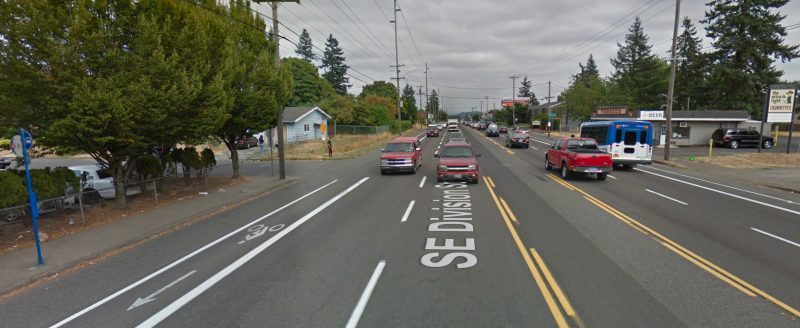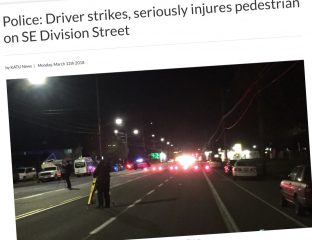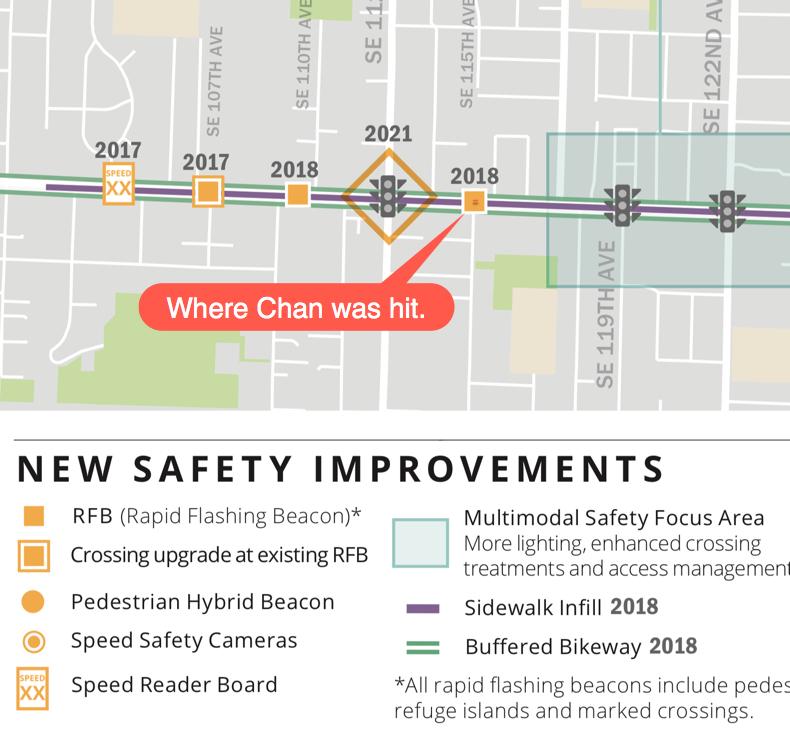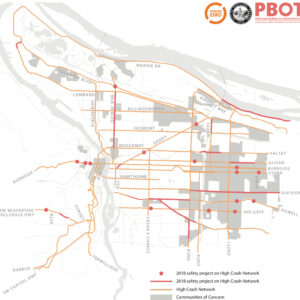

Outer Division. Again.
Around 8:30 pm on Sunday night 74-year-old Portland resident Fuk Chan tried to walk across Southeast Division Street near 115th. He was struck and severely injured by a man driving a Nissan Quest minivan. Mr. Chan died in the hospital yesterday.
Based on the Police narrative released so far and from a photograph in a KATU story, it appears the collision happened near a TriMet bust stop on the north side of the street, just west of 115th. There’s a small market on the south side of the street.

Division is nine lanes wide in this location. There are parking lanes and bike lanes on both sides as well as two standard vehicle lanes and a center turn lane. There’s 1,829 feet (one-third of a mile) between marked crosswalks.
Outer Division has been the focus of attention from bereaved families, safe streets activists, and the City of Portland for many years. In December 2016, following the deaths of two people killed in separate collisions within hours of each other while walking across Division, Portland City Council passed an ordinance that freed up $300,000 for “emergency” safety updates.
Admirable advocacy from the City of Portland continued into last year when a formal safety action plan was released in February at a community meeting held on SE Division at 82nd. At that meeting PBOT Commissioner Dan Saltzman told local residents (many of whom needed a translator because English is not their native language), “We’re sorry and we’re bound and determined to do something about that.”
That was 13 months ago.
Changes are planned for the section of SE Division where Chan was hit, but they haven’t come soon enough.
Advertisement
That project Commissioner Saltzman presented in February 2017 — which was initially called the “Outer Division Multimodal Safety Project” and is now for some reason been changed to the “Safety Action Plan for Outer Division” — includes a list of safety updates aimed at reducing driving speeds and creating more protection for vulnerable road users.
But how long must we wait before they are built? (I’ve asked PBOT for an update and will share when I hear back.)
In a sad twist, it appears the exact location where Mr. Chan was hit is waiting for a new rapid flashing beacon, median island and marked crosswalks.

The last time we reported about PBOT’s Outer Division project was in November 2017. At that time the project had been delayed due to concerns from local business owners that the safety upgrades would result in too many lost parking spaces and not enough room for large trucks to make turns. “Across the board we have overall support,” a PBOT project manager told the city’s Bicycle Advisory Committee in October, “But we’re also hearing, ‘Wow, losing on-street parking will be a big deal for our business,’ and, ‘How’s freight going to work?'”
Another factor causing a delay in making this street safer is the budget shortfall that has paused the (mostly) federally-funded Division Transit Project. PBOT and TriMet want to coordinate work on Division; but that’s proving to be more complicated than expected.
But it’s not all bad news: In January we reported that PBOT plans to construct a raised center median and protected bike lanes on Division between 116th and 146th before the end of 2018. At least that’s the current plan.
As the daily threats — and often consequences — to human life persist on outer Division, activists are now sounding the alarm about outer SE Stark.
With the way we currently approach fixing deadly and dysfunctional streets, it will likely take much more activism — or unfortunately, more deaths — before anything gets done.
Note: Mr. Chan was the seventh person to die while using Portland streets so far this year. 65-year-old Portland resident Wes Hatton died at a hospital on Saturday (3/10) after he was hit while walking across SE Belmont at 30th on Friday.
— Jonathan Maus: (503) 706-8804, @jonathan_maus on Twitter and jonathan@bikeportland.org
Never miss a story. Sign-up for the daily BP Headlines email.
BikePortland needs your support.





Thanks for reading.
BikePortland has served this community with independent community journalism since 2005. We rely on subscriptions from readers like you to survive. Your financial support is vital in keeping this valuable resource alive and well.
Please subscribe today to strengthen and expand our work.
Perhaps Mayor Wheeler needs to declare a [vision zero / traffic safety / _________] state of emergency – 15.04.040 – for many of the City’s now out-dated arterials per design…and have PBoT block off (barrels in the short term) the often “extra” lane of all of these 4 and 5 lane arterials to improve traffic safety through reduction of intersection conflict points…this would allow the Mayor to act promptly and issue contracts swiftly for any resources that the City does not have internally…
Businesses preventing safety improvements because they rely on automobile parking in the public right of way should be held accountable when things like this happen.
That stretch is primarily residential and empty lots.
“the project had been delayed due to concerns from local business owners that the safety upgrades would result in too many lost parking spaces and not enough room for large trucks to make turns.”
At 92nd, yes. But at 115th, I’d beg to differ.
Those concerns are legitimate.
They are, but what is our priority here? How much do we value parking space versus lifes?
Of course lives are more valuable than parking spaces. But casting this as parking-vs.-lives isn’t accurate, or conducive to identifying the range of potential solutions.
Parking vs lives is exactly what this comes down to. I’d ask which you value more, but you’ve made it clear.
That’s the kind of dismissive, hostile stance that makes the safety issue harder to solve.
Think about it–you just told me I value parking more than lives.
If you did that at a public meeting where a business owner said he or she was concerned about losing parking, you’d instantly polarize the situation, and lose any goodwill that person might have come in with.
And I think if you’ve read a few of hundreds of comments I’ve made here, you’d know how laughable your idea is that I care more about parking spaces than lives.
“Parking vs lives”
needlessly hyperbolic.
Language like this we’ve been hearing around gun control in the past few weeks isn’t even true, even as we may prefer simple binaries.
I meant to respond to BB here, but my response is down at the end of the comments.
The businesses have as much right to express their concerns as anyone. And the businesses are not “preventing safety improvements”. They don’t have that power. It’s the City that’s determining the timetable for improvements.
And if businesses really could be held accountable for these deaths because they rely on on-street parking, their two best options might be 1) move out of the neighborhood or the city, or 2) turn land along the street into private parking lots. Both would harm the area.
The problem is the city is asking them in the first place. Fix the street, ignore the whiners, rinse, repeat. That’s how they make progress in places that make progress.
People asking for bike infrastructure were the whiners in the past, and still are considered whiners by many. We’d have many more freeway lanes and widened streets if it hadn’t been for whiners.
There are people now saying to ignore criticism from people not wanting to widen I-5, under your same, “That’s how they make progress in places that make progress” reasoning.
That doesn’t mean you scrap making safety improvements because it will cost some parking spaces, either, in case you think I’m saying that.
As usual q said what I was tempted to say, but better.
I sympathize with your sentiment, but our city fathers have so screwed up in the past I have become gun shy making such recommendations. I wonder, though, if we couldn’t come up with a decision hierarchy that, oh, I don’t know, prioritized human transport such that this was the default policy everywhere, and those who pushed back had to justify their concerns w/r/t that overarching goal. We could then develop this further to arbitrate reasonable concerns, that avoided having this degenerate into a lobbying fest with no reference to larger policy priorities.
I hear you; I am not opposed to the city asking people about their opinion. But we need have our priorities right! I see VZ as prioritizing lifes over other parking spaces or travel time, but this delay indicates that the city has a different perspective on that.
Right, I mean, voters elected city council members who in turn voted on things like Vision Zero, modal hierarchies (climate action plan,) the Central City plan, etc. The city already has the political cover to move forward with changes which are consistent with those directives. I don’t see how it’s constructive/necessary to solicit feedback on every individual proposal thereafter. Pedestrians are getting hit and killed by cars in areas with no safe sidewalks or crossings. Either we (the City of Portland) has a modal hierarchy we values pedestrians over single occupancy vehicles or we don’t.
I lived on Division for years and used it from 60th to 174th daily. I could barely cross the street at 64th to get to the bus stop. The road was dieted and the traffic volime remained constant. As I drove to work, I would see all kinds of people trying to cross the street. The lighting on the street is pathetic. The LEDs don’t do much for horizontal viewing. I’d compared them to high beams to regular lights that “auto-users” use. Also, auto-users speed their brains off. In my years of making that commute I rarely saw police officers, aside of the ones making arrests. I think we are in an emergency situation and the commissioners won’t budge. We need cops. We don’t need PBOT policing. It’s not their job or their role. And yes, we need cops catching speeders, jaywalkers, and anyone else that doesn’t follow the rules. Will this actually happen? I doubt it.
The question I have when we learn of situations like this (again) is how other countries handle this? Sweden, The Netherlands, Germany, Norway, Denmark, Australia? Do they adopt Vision Zero and see the numbers rise? What is going on in other jurisdictions? What actions are taken? How is the message communicated to those behind the wheel? Are drastic actions sometimes taken? What are they?
Too often we proceed as if the problem before us were entirely new, had never been addressed by anyone.
portland and many other US cities weren’t built around horses and the flintstone-mobile like the countries that you mentioned. We wouldn’t be where we are today without some form of advanced transportion. Whether that is perceived as good or bad.
You mentioned Vision Zero. Sounds like a poor copy and paste project.
Amsterdam in the 1970’s had tons of roads that look like Division and Powell. They were dramatically transformed to prioritize active transportation, and it worked wonders.
These pre-car maps disagree:
http://maplib.blogspot.com/2011/05/1896-cyclist-road-map-portland.html
http://sos.oregon.gov/archives/exhibits/constitution/PublishingImages/after-social-portland.jpg
I wouldn’t mind living in a 1896 Portland, but that’s probably
More of a pipe dream then anything.
Every commute would be a cyclocross race!
Portland Oregon was incorporated in 1851, my home was built in 1907 with horse drawn transport of materials and labor.
Built with trees from Forest Park? 🙂
Depending on where Tom’s house is, there were likely a lot of trees closer than Forest Park. 1907 is on the tail end of the huge building boom during the ten years prior to the Lewis and Clark Expo.
I’m a big fan of the new LED street lamps we’ve got. But out here, with the wider streets, and I swear the distance between lamps is farther apart than if you’re closer in, good god, it’s so dark. If you are walking on Division/Powell/Holgate on the side of the street opposite the lamps, it’s dark. Plus the shitty sidewalks and sometimes no sidewalk? Walking after dark is terrible.
The city has spent increasing amounts of money on homeless services, allowed illegal camping and chop shops by the homeless along transportation corridors like the Springwater and completely neglected roads that have become increasingly deadly to taxpayers. If transportation got 1/10 of the press that homelessness gets we might have a chance to get around our city safely. As it is I have to bike around on bike lanes that are covered in gravel almost a month after a storm and dodge potholes on my bike commute. The city is increasingly wasting our money on non-core spending which would be fine if our transportation system was good but it is not. I can’t remember the last time I saw a Portland Police officer with a car pulled over for speeding, distracted driving or reckless driving but I see those activities with sickening regularity.
I’m not sure it is necessary or warranted to pit homelessness against transportation safety. We are supposedly the richest country in the world? Why are we arguing over crumbs all the time?
Oh, right. The military budget.
How about $200+ million for CRC studies, $250 million for the Newberg bypass, $70 million for the Woodburn interchange, $365 million for the Hwy 20 realignment, $450 million (yeah, right) for the RQ expansion for SAFETY IMPROVEMENTS. Ha ha.
The city budget is not infinite regardless of what the city council thinks. Luckily the city does not have to spend any of its budget on national defense, social security, medicare, or medicaid. What the city does need to do is prioritize the money they have which is substantial. For my personal budget I prioritize things like housing, food, and utilities. If I am low on money I spend first on those before going out to eat or vacations. In my opinion the city should first spend on public safety (police, fire, and in some ways transportation), water/sewer, roads/transport, Parks, then everything else like neighborhood involvement, homeless services, office of equity and human rights, etc. that are not core items. The city has increased spending on homeless services by 165% over the last 5 years from $10 million to $26.5 million. At the same time we have been asked to pay new extra taxes to pay for transportation safety.
The 2017-2018 budget allocated $563 million dollars on public safety and you are complaining about an extra $15 million spent on houselessness?
Novick was right that there is still a lot of unproductive fat to be cut in the public safety budget.
https://www.portlandmercury.com/BlogtownPDX/archives/2014/03/31/novick-gets-a-public-conversation-on-cutting-cops-drug-unit
Maybe cutting the police drug unit is NOT a good idea…. http://katu.com/news/local/drug-overdoses-kill-more-people-than-car-crashes-in-oregon-washington
Seriously? Helping the homeless isn’t taking money away from street safety. That assertion is ignorant and offensive.
The pentagon has not had an audit in how many years? We are not even allowed to know the “dark” budhet. Yeah. There’s where your quality-of-life issues lose out. Does anybody know how many wars the US is in right now or is soon to be engaged?
ODOT removed some car parking spots on SW Barbur Blvd last year. I prefer riding it now versus early 2013.
The bridges are still scary/dangerous though. That’s the biggest barrier for me wanting to bike on it.
Google street view even shows someone who appears to be trying to cross at this location: https://www.google.com/maps/@45.504196,-122.5448769,3a,60y,75.92h,77.11t/data=!3m6!1e1!3m4!1sqBr3Rvl6DUMviwuBxRr54Q!2e0!7i13312!8i6656
Truly scary.
Also evident in this street view is the complete lack of anyone trying to park on-street.
Very few homes plus empty fields would cause people to not use the street to park their vehicles. Most people are using that stretch as a used car sales strip or a spot to park their RV.
Mr Chan. Listen and do not be distracted
OM MANI PADME HUM
“We’re sorry and we’re bound and determined to do something about that.”
That was 13 months ago.
Someone died and most all the comment published are oblivious to this as they rant about the usual internet fare….
Nice.
Remember, if you’re not happy about this or any other situation with transportation, be sure to contact your elected officials and civil servants.
Dan Saltzmam
Ted Wheeler
Leah Treat
Etc.
Ted Buehler
One of the key reasons that there is limited changes happening on SE Division (and others) is there no direct City Council representation for residents. Residents of Portland are unable to call a City council member responsible for SE Portland and say, enough, fix it or I’m going to vote you out next election. You can repeat this scenario for dangerous, problematic roads in SW, NE etc. The organization of Portland City government is deeply flawed and un-workable for a city of this size. Until this gets fixed with a City Council with geographic districts that is directly accountable to residents and a City Manager, City budgets will be spent within silos and necessary projects like this will get tossed around like a political football.
Thanks Rachel.. flagging this for comment of the week consideration.
Great, thank you!
Rachel, I hear what you are saying…but I am not sure that the solution you seek will be of much help without creating new problem(s).*
[*I have lived in cities with both representations…and often the “ward” based system seemed to force staff to create solutions that forced that same solution equally no matter the need – and this was in a city larger than Portland.]
Thanks for thinking about this and sure, I can see that happening, but perhaps that’s where the City Manager comes in, they are able to see the issues at a better distance and can prescribe something other than the one size fits all/all districts are equal.
True, that the “City Manager” is an additional decision maker that can help the “equity” of resource process along…I have worked with and for several over 30 years…more often than not the really big and seismic positive decisions for multimodal/ vulnerable roadway users (safety & facilities) have instead come out of the “Strong Mayor” model…think NYC, Chicago etc. over the last 20 years…politically challenging decisions (parking removal and business access restrictions) that often city managers fear to make if they ever even make the light of day at a council meeting.
BB–besides being wrong that I value parking more than human lives, you’re also wrong that “Parking vs lives is exactly what this comes down to”.
There are streets throughout the world that include parking but that are also safe, vibrantly urban, pedestrian- and bike-friendly. In fact, removing parking can make a street worse in those regards. And many of the very WORST streets for safety and livability have no on-street parking.
Of course there are cases where removing parking will make a street safer, because it allows room for wider sidewalks and/or bike lanes, for instance. But that doesn’t mean removing all spaces is always better, even if you ignore impacts on a business and think only of safety.
Examples why “parking vs. safety” is a shortsighted stance:
— (very relevant to this article)–adding better crosswalks–markings, lighting, islands, etc.–requires removing little or no parking.
–streets that attract businesses are better for pedestrians for safety and character than streets with struggling businesses. If businesses think they won’t succeed without on-street parking, businesses won’t locate or stay there. So keeping at least some parking can make a street safer.
–one strategy to address loss-of-parking concerns isn’t keeping parking, but adding better bus service. But if you dismiss the reasons behind why a business is objecting to losing parking, that strategy might never get identified.
–another strategy is to change zoning to allow greater density, so eventually you’ll get more pedestrian traffic. Property owners may be more willing to accept some loss of parking if needed for say, wider sidewalks, if they know it increases the value of their property long-term.
–often, it’s better to make room for wider sidewalks or bike lanes by removing vehicle travel lanes, or narrowing them, than by removing parking.
–removing on-street parking can make developers more likely to build parking lots, or to NOT replace parking lots with new development, which can create a less urban, less safe street for pedestrians.
–moving parking out so the bike lane is between the parking and sidewalk is a safety improvement that doesn’t require removing on-street parking
I could go on. The point is that attacking people who defend on-street parking as valuing parking over human lives is aggressively hostile and counter-productive.
Rachel wrote:
“One of the key reasons … …is there no direct City Council representation for residents. Residents of Portland are unable to call a City council member responsible for SE Portland and say, enough, fix it or I’m going to vote you out next election.”
While this is a contributing factor, I suspect that you can go to any city in the US with district council representation and find streets just as heinous as SE Division.
Because, while having district representation would *help* this kind of problem, it still takes a fair bit of effort to get this type of problem solved. The one councilor is only one vote, and historic inertia and bureaucratic inertia always drags its feet in cases like this.
So, even with more direct representation, it still takes a lot of work — by grassroots advocates, neighborhood associations, staffed advocacy organizations, bureaucrats within the system, and/or the elected officials themselves to make the changes needed.
In my experience, Portlanders overemphasize the benefits that changes to the governance system *could* make, and underappreciate the benefits that advocacy, here and now, within the existing system *will* make.
For instance, in Dec 2016, 2 people were killed crossing SE Division on one night. BikeLoudPDX co-chair Jessica Engleman immediately began organizing a direct action/civil disobediance campaign to make the street safer. She probably put in 40 to 80 hours of organizing, entirely as a volunteer, and changed the street for an hour or two, and got very good media coverage. As a result, APANO joined up with BikeLoud, and we made a concerted effort to get PBOT to make immediate changes. And, within a week or two the speed limit was lowered, and within a month or two there were new speed ticket cameras on the street. And various other mitigation efforts.
Without Jessica’s efforts, and the organizational structure of BikeLoudPDX, its likely that only some of these things would have come about. And while people are still being killed crossing SE Division, more of them would have been killed in the last 14 months.
With leadership, vision, clear requests for off-the-shelf improvements, we can make changes to the world today.
With claims that no effective change can occur until structural changes are made in governance structures, we’re playing a defeatist game.
Unfortunately Jessica had priorities come up in her personal life and was no longer able to continue her role in Portland transportation advocacy, and none of us current co-chairs have time, energy and expertise that she has, so we havent’ done any similar direct action/media focused events since. But, we certainly will again.
Recognize the roles that grassroots or other advocacy can play in changing our world, today. It’s a much more rewarding path to take than to shoot for some possible structural change far off in the future…
My $0.02
Ted Buehler
Co-chair, BikeLoudPDX
In related news…
http://www.oregonlive.com/portland/index.ssf/2018/03/two_pedestrians_suffer_serious.html